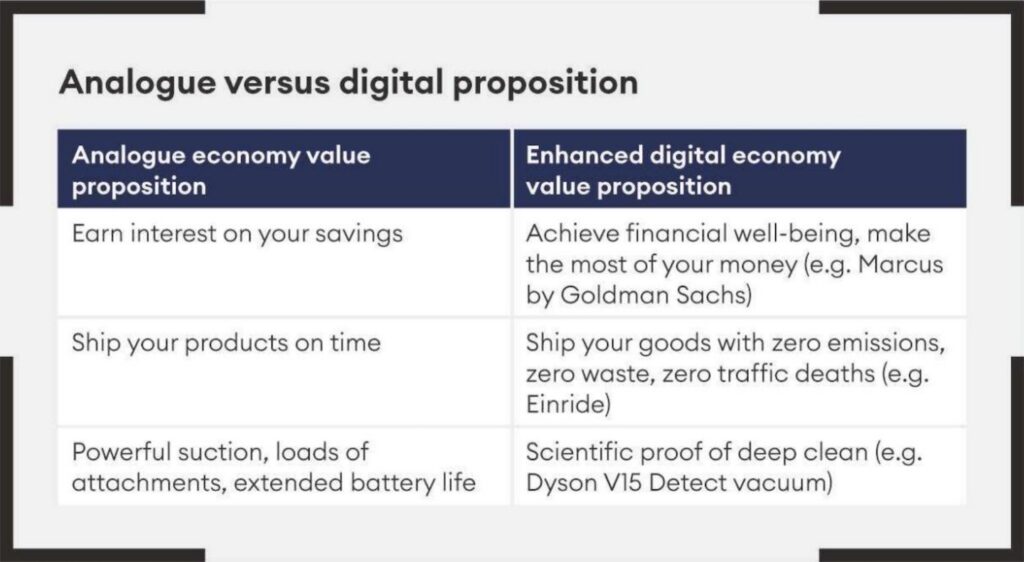Selling on the basis of product features may have worked in the analogue economy, but in the digital era leaders need to refocus on customer outcomes.
The digital economy provides organizations with incredible capabilities for connecting with customers, talent and other stakeholders. But the way companies use digital tools often reveals an underlying blind spot: even when business leaders embrace the latest technology and marketing channels, the mindset that drives their approach to customer centricity may be stuck in the business-as-usual analogue economy.
In many organizations, customer centricity lives at the intersection of product and marketing. Product teams seek to understand and solve customer problems, while marketing teams design and deploy campaigns and user-experiences across channels to capture customer data and drive sales. Such approaches to customer centricity successfully modernized and transformed many marketing strategies in the analogue economy. Digital economy leaders, however, differentiate themselves by going beyond problem-solving and experience, to focus on enabling customer outcomes.
Here is the starting point that many businesses miss: re-examine the outcomes your customers are trying to achieve and reframe the business model that allows you to help them. Product teams can flaunt the most advanced features and marketing can brilliantly showcase an organization’s message – but not even the flashiest digital capabilities can compensate for an out-of-date value proposition. In a digital world, customers are a simple click away from accessing your products, services, and brand – so what do you want to tell them?

Mindset shift
Digital technology enables – or in certain competitive contexts, demands – a mindset shift, eclipsing core products and allowing businesses to compete on advanced digital capabilities.
The problem with the traditional view of customer centricity is that it’s anchored in selling products and services to customers. That might not sound like a problem – after all, companies need to do that to exist. But this traditional approach may no longer be enough. The table below demonstrates the difference.
The core value proposition is implicit in the extended value proposition. That is, it is by enhancing the core value proposition through advanced digital capabilities that products and services achieve differentiation. Competition is no longer solely at a product and features level. It’s about employing digital to bring additional value to customers.
Take the example of the UK energy firm Bulb. It “makes green energy simpler, greener, cheaper”, by providing members with 100% renewable electricity from solar, wind and hydro power, and offsetting gas-related carbon emissions through carbon-reduction projects. The core product is no different from other retailers – the lights turn on the same way – but the company provides additional value by meeting sustainability targets and supporting consumers’ personal goals.
Think about it this way: when you focus on improving the way customers understand what you have to offer, that’s a product-centric approach. It’s ‘inside-out’ thinking, because the starting point is rooted in your goal of selling more product: “Here are all the great things about our product, here’s why you need it, now come and buy it, and here’s a great customer experience in our channel.”
Digital leaders can shift that focus and employ ‘outside-in’ thinking by asking themselves what outcomes customers are seeking, and exploring ways to make customers’ lives better. If you lack a thorough understanding of your customers’ objectives, then you are missing the point of customer centricity and the opportunities that it represents.
Delivering customer outcomes in the digital age
The idea of customer outcomes is an important concept to understand, because it’s essential to developing an up-to-date, expanded view of customer centricity.
Customer outcomes and customer needs are not necessarily the same thing. For example, a customer may need a mortgage, but their desired outcome is a safe and comfortable home in which to raise their family; nearly no one actually wants a mortgage. With customer outcomes, we must put ourselves in the shoes of the customer and understand what they’re really trying to achieve. From there, we can design our product and service offering.
The evolution of Amazon’s e-commerce capability illustrates the concept. Amazon started by creating broad online product catalogues, creating a secure, multi-channel marketplace between buyers and sellers, and ensuring correct payment and distribution. This is where many other e-commerce platforms have stopped – but Amazon understood that there was more to do for their customers. Through Alexa, customers can order products while making dinner, nodding off to sleep, or during their commute. Digital provides new convenience.
Yet in some locations even this wasn’t enough to provide a complete customer experience, as thieves were regularly helping themselves to packages left on the doorstep. How did Amazon fight theft? For US$1bn, they acquired Ring, a smart doorbell which allows customers to see a delivery person, open their door, see the package delivered inside their home, and then close and lock the door. They also acquired Whole Foods, creating a network of pick-up and drop-off lockers.
This example illustrates a critical difference between the analogue and digital economies: the ability to create end-to-end value propositions via ecosystem business models. Companies can simplify customers’ lives by linking multiple steps. Instead of making a customer figure it all out on their own, a provider can structure an entire process, enabled by data, that lets the customer achieve their goal.
How leaders can develop this new mindset
Smart leaders don’t simply give marketing the lead role in customer-centric strategy. Instead, they recognize that customer centricity is grounded in a well-defined value proposition. Marketing activities flow from that.
The digital age requires a new definition for customer centricity: it is the mindset of identifying, exploring and delivering customer outcomes.
Clayton Christensen’s 2005 ‘Jobs to be Done’ model may be the most powerful harbinger of the digital business models which are winning across the economy today. His invitation to leaders to think beyond product features remains essential.
Yet, like customer centricity, jobs to be done can be poorly understood. In my sessions with leaders across industries, I regularly ask, “What are the ‘jobs to be done’ of your customers?”, only to receive responses such as “Customers want to find information about my products”, or “Customers want to purchase my products”. I’ve worked with hundreds of executives who believe their customers’ goal is to get a loan, or buy a consumer product, or book a vacation. Such a limited focus on product ultimately allows competitors to deliver customer outcomes and gain a competitive advantage.
We can do better. To win in the digital economy, leaders can pave the way to these new opportunities by asking questions that prompt organizations to rethink long-held assumptions – and deliver a fuller complement of products and services which help customers to realize their objectives.
The fintech Revolut, for example, operates in over 35 countries, serving over 500,000 businesses and 18m personal users. A quick glance at their offerings for business customers is instructive. Do business globally, from day one; control team spend and permissions; avoid the hassle associated with expense management; end overspending with smart budgeting; spend abroad like a local; grow your wealth. They are highly outcome focused. Of course, Revolut has products and services which enable these outcomes, but those are not the focus of their value proposition.
Incumbents can take advantage of such new-style positioning too. Goldman Sachs’ online division Marcus, for instance, is equally clear about its mission: “We created Marcus to help people achieve financial well-being.”
The approach I have used with many Fortune 500 corporations, governments and start-ups is to reframe their strategies from product feature-focused to customer outcome delivery, as set out in the model (below).
Leaders can also task their teams to challenge existing assumptions and anchors around customer centricity. Critical questions to ask include:
- Are we continuously learning about customer objectives? Recognize that this exploration is not a one-and-done activity. It requires constant curiosity and a willingness to be wrong.
- If all of our flashy customer experience features went away, would customers still have the value we want them to have? Or is digital marketing hiding a lack of new strategic thinking?
- Is it easy to do business with us?
- Are our transactions and interactions traceable and transparent?
This last question will become increasingly important, as demands for ESG-related disclosure continue to rise and economic models based on Web 3.0’s ‘Internet of Assets’ technologies emerge.
How an expanded view of customer centricity benefits your organization
Thinking about customer centricity in terms of customer outcomes will quickly strengthen many aspects of your business.
Strategic clarity When leaders ask questions that prompt a careful, thorough re-examination of customer goals, it compels the organization to refine its purpose. A strong sense of purpose guides business decisions and separates the signal from the noise. You’ll pursue opportunities and investments only when they’re relevant to your purpose – and as a result, you’ll use your time and resources efficiently.
A clear value proposition that guards against disruption By expanding your value proposition beyond products, you both create competitive advantage and build protection against unexpected disruption.
Customers become stakeholders in strategic direction As we make decisions that further our ability to deliver the outcomes we’ve identified, we can also engage customers in shaping what’s next. By understanding how customers’ desired outcomes are evolving, we can continue to meet them.
Customer-centric thinking also applies to employees and shareholders The customer centricity mindset isn’t limited to the people who buy your products and services. We can employ the same models for how we think about our talent and shareholders. In a world where the Great Resignation has made recruiting a challenge, job candidates often want to work with organizations which have a clarity of purpose. That requires a meaningful answer to the question, “Why are we in business?”
The cultural benefits are considerable. It creates employee engagement around a shared purpose, and as that culture develops, it in turn leads to clearer incentives for your workforce in terms of their contribution to delivering customer outcomes.
Shareholders may have similar questions, particularly in the context of increased interest in ESG. As you move towards delivering end-to-end solutions to the outcomes you’ve identified, your company becomes much more than a seller of products or services.
Beyond product and channel
As you begin to rethink and expand your customer centricity mindset, start with a basic strategic question: “What is the customer trying to achieve?” This question sounds simple, but it’s not. Understanding customer outcomes takes effort and empathy.
When you truly understand your customer outcomes, it will inform your value proposition for the future, as you describe how you’ll deliver those outcomes. Your strategy, your business model and your partnerships, products and services all need to be aligned.
If outcomes aren’t the starting point, customer centricity risks being product-first marketing by a different name. Your strategy will stem from a relic of the analogue economy, when fewer opportunities existed with data, customer intimacy, end-to-end instrumentation.
You might have great marketing capabilities and terrific product features. But the question in the digital economy is: to what end?





